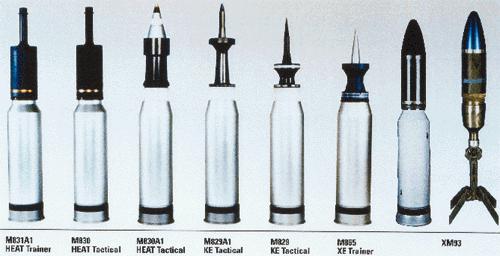Tank Projectiles
Home
Types
When tanks were
first introduced there were basically 2 types of
shells; a solid shot used on other tanks and
fortifications and a high explosive shot used on
infantry and light cover. Today's tanks fire a
variety of projectiles that can be applied to
all sorts of problems. The most common rounds in
use today are a high explosive anti-tank (HEAT),
armor piercing fin stabilized discarding sabot
(APFSDS), high explosive squash head (HESH), and
high explosive (HE). Below is a picture of what
the US Abrams tank uses (m828, and 829A1 are
APFSDS).
 Image
source:https://fas.org/man/dod-101/sys/land/120MMRDS.JPG Image
source:https://fas.org/man/dod-101/sys/land/120MMRDS.JPG
The
Physics
Today's tank guns are not rifled
meaning that shots from the cannon
do not spin which makes them less
accurate. The way to help negate
this is to use shells that have fins
that deploy after the round leaves
the cannon barrel. This then helps
the rounds fly straight as well as
lessening the drop of the projectile
because of the way the air moves
over the fins. Think of it like the
wings on a plane, only on a smaller
scale. Another type of shot is
discarding sabot shot. This shell
type has a sabot that helps
stabilize the shell in the barrel
which then falls away after the
shell leaves the barrel. Pictured
below is an APFSDS shell being
fired.
Image
source:http://static.panoramio.com/photos/large/29178126.jpg
The
real physics begins when we start
talking about the effect these
shells have on their target because
each of them utilize a different
method of causing damage to the
inside of a tank. Below I'll talk
about the three most commonly used
against enemy armor.
The
first shell type is high explosive
squash head or HESH. HESH does not
penetrate the target, rather it
impacts. The head of the projectile
then conforms to the surface where
it explodes, sending a shock wave
through the armor and creating
sprawling, an effect where the tanks
own armor comes apart and causes
damage to the inside of the tank.
Below is a picture depicting this.
Image
source:http://armoredtalk.com/wp-content/uploads/2015/12/image00.png
The second ammo type is high
explosive anti-tank (HEAT). HEAT has a conical
cavity with a copper lining and a high explosive
charge behind that. When this shell hits, its
explosive charge goes off and the cone directs
the molten copper into a stream that then
penetrates the tank and causes damage. Below is
a picture depicting this.

image
source:http://www.robinsonlibrary.com/military/artillery/ordnance/graphics/apshell3.gif
The third and final shell is APFSDS or armor piercing fin
stabilized discarding sabot. This is a
kinetic energy shell that relies on
brute force to penetrate the targets'
armor. These projectiles are often under
sized for the gun and rely on a sabot to
help them leave the cannon. Once they do
they are stabilized by fins until they
hit their target where they penetrate
the armor and cause damage.
|